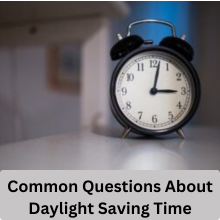
Hey there! Have you ever wondered about the annual clock-switching tradition we call daylight saving time (DST)? It’s that time of year when we play a little game with our clocks, and it can leave many of us scratching our heads. Knowing when daylight saving time ends is crucial, especially if you want to make the most of those shorter days. Let’s dive in and get you all the information you need about when daylight saving time ends in Wisconsin in 2024!
Key Dates for Daylight Saving Time in Wisconsin
When Does Wisconsin Fall Back in 2024?
Mark your calendars! In 2024, Wisconsin will “fall back” from daylight saving time to standard time on November 3, at 1 a.m. CDT. That means that when the clock strikes 1 a.m., it will turn back to midnight, giving us all an extra hour to enjoy.
Significance of the “Fall Back”
This change isn’t just about resetting the clocks; it’s also a great opportunity to catch up on some much-needed sleep. Remember, this is when we gain an hour of rest, making that Sunday morning feel a little bit sweeter. So, whether you plan to sleep in or just enjoy an extra hour of relaxation, this transition is a win-win!
Understanding Daylight Saving Time
How Daylight Saving Time Works
So, what exactly is daylight saving time? It’s a practice that involves setting the clock forward by one hour during the warmer months to extend evening daylight. This means more time for outdoor activities after work or school.
Reasons for Implementing DST
The main goals behind DST include saving energy, enhancing public safety, and allowing for more daylight during evening hours. It was first introduced in the U.S. during World War I to conserve fuel. Today, it’s still debated whether the benefits outweigh the drawbacks, but the tradition remains strong.
Shortest Day of the Year
When Is the Shortest Day of 2024?
Curious about the shortest day of the year? It falls on December 21, 2024, which is the winter solstice. On this day, we experience the least amount of sunlight. The sun will rise late and set early, making it feel like the day just flies by!
Future of Daylight Saving Time
When Does Wisconsin Spring Forward in 2025?
Looking ahead, Wisconsin will spring forward again on March 9, 2025, at 1 a.m. CDT. So, if you’re not a fan of losing that hour of sleep, you might want to prepare yourself for that day!
How to Prepare for the Time Change
Adjusting Clocks
When it comes to changing your clocks, it’s easier said than done. To help yourself remember, set a reminder on your phone or leave sticky notes around the house. A little prep goes a long way, especially when it comes to maintaining a routine.
Also read: The Dark Side of Abortion Bans: Rising Infant Deaths
Health and Sleep Considerations
Changing the clocks can impact your sleep schedule. It’s a good idea to start adjusting your bedtime gradually in the days leading up to the change. This way, you won’t feel too groggy on that Sunday morning!
Common Questions About Daylight Saving Time
Why Does DST End at 2 a.m.?
You might be wondering why the clock changes at 2 a.m. rather than some other time. It turns out, this tradition has roots in the railroad industry. Back in the day, trains didn’t run at 2 a.m., so it was the least disruptive time for everyone.
States Not Participating in DST
Not every state plays by these rules. For instance, Hawaii and parts of Arizona do not observe daylight saving time. In addition, some U.S. territories, like Puerto Rico and Guam, also skip this annual clock change.
Impacts of Daylight Saving Time Changes
Effects on Daily Life
The shift in time can have ripple effects on daily activities. Think about transportation schedules, business hours, and even school times. It’s amazing how one hour can create a domino effect in our routines!
Public Safety Considerations
Research shows that changing the clocks can lead to an increase in accidents and health issues right after the time switch. For example, studies have indicated a rise in heart attacks and traffic accidents following the spring forward. This makes it crucial to be mindful of your well-being during these transitions.
Also read: LeBron & Bronny: The Historic Father-Son NBA Debut
Conclusion
In summary, knowing when daylight saving time ends in Wisconsin in 2024 is essential for planning your fall and winter activities. With the transition happening on November 3, you’ll gain an hour of sleep and a chance to embrace the cozy fall vibes. As we navigate these changes, let’s keep our health and schedules in check.
FAQs
What time does daylight saving time end in 2024?
Daylight saving time ends in Wisconsin on November 3, 2024, at 1 a.m. CDT.
Will we gain or lose an hour when DST ends?
When DST ends, we set our clocks back an hour, meaning we gain an hour of sleep!
What is the Sunshine Protection Act?
The Sunshine Protection Act aims to make daylight saving time permanent. It was passed by the U.S. Senate in 2022 but hasn’t been fully enacted yet.
How do I adjust my sleep schedule for the time change?
Gradually shift your bedtime in the days leading up to the time change to avoid feeling groggy.
Why was daylight saving time introduced?
Daylight saving time was introduced to save energy and maximize daylight during longer days, allowing for more outdoor activities in the evening.

